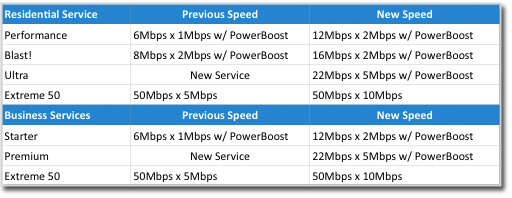 If you’re in need of faster broadband (and who isn’t!) then you need to know what Comcast is delivering starting today, although it may not be as wide open as you might hope.
If you’re in need of faster broadband (and who isn’t!) then you need to know what Comcast is delivering starting today, although it may not be as wide open as you might hope.
Comcast announced it is making the leap from broadband to wideband with the launch of next-generation DOCSIS 3.0 in over 10 U.S. markets (including the Twin Cities) and doubling the speed of existing service for most customers.
This move is certain to help them stave off competition in some markets — mainly in the northeastern US covered by Verizon with their fiber service and 50mbps down, 20mbps up service — as well as position Comcast to deliver a host of new services.
As part of this new wideband deployment, Comcast will launch two new premium speed tiers to its residential and business class customers, Extreme 50 and Ultra.
New Residential Tiers
• Extreme 50, offering up to 50 Mbps of downstream speed and up to 10 Mbps of upstream speed at $139.95/month.*
• Ultra, offering up to 22 Mbps of downstream speed and up to 5 Mbps of upstream speed at $62.95/month.*
With Extreme 50, Comcast customers, for example, will be able to download a high-def movie (6 GB) in about 16 minutes, a standard-def movie (2 GB) in about 5 minutes and a standard-def TV show (300 MB) in a matter of seconds. Customers with Extreme 50 also will be able to download digital photos, songs and games faster than ever.
*This pricing is for residential customers and requires a subscription to Comcast Cable service.
New Speeds for Existing Customers (at no extra charge)
In addition to the new speed tiers, Comcast also is increasing speeds for most of its existing customers:
• Performance tier customers will benefit from doubled downstream and upstream speeds, offering up to 12 Mbps and 2 Mbps, respectively.
• Performance Plus customers will be upgraded to Comcast’s Blast! tier, which will double their download speeds to up to 16 Mbps and provide up to 2 Mbps of upload speed.
Plus, with Comcast’s PowerBoost® technology, customers are able to achieve even faster speeds to download and upload files, though my experience has been that it’s usually only the first 10 or 15 percent of a file that gets “boosted”.
 Will these new tiers of service be subject to Comcast’s new (as of October 1st) 250GB download limit for their customers? This was a move widely seen as defensive, since so many providers have appeared with bandwidth-consuming, downloadable and viewable video content (e.g., Apple movies, NBC’s Hulu, CBS, Google’s YouTube) and Comcast would undoubtedly like to control content distribution as it’s delivered over the series of Comcast tubes.
Will these new tiers of service be subject to Comcast’s new (as of October 1st) 250GB download limit for their customers? This was a move widely seen as defensive, since so many providers have appeared with bandwidth-consuming, downloadable and viewable video content (e.g., Apple movies, NBC’s Hulu, CBS, Google’s YouTube) and Comcast would undoubtedly like to control content distribution as it’s delivered over the series of Comcast tubes.
No question they do have to manage their network, as any good I.T. person will tell you. Especially as more of our applications are in the cloud and we move around ever bigger file types over the internet.
In my office, we have the 50/5 service (that’ll go to 50/10) and it’s awesome. My speed at home is 16/2 and it too, is great and yes, I always want more. But I also pay good money for both services and want to access the HD content from whom I choose to consume it, use the digital telephony provider I want to utilize, and not be concerned about whether or not I’m going over an artificial and arbitrary ceiling. I suspect that other Comcast customers will feel this way as soon as people go past the limits and have accounts cancelled in droves.
In the meantime, I’m delighted to see this DOCSIS rollout and that the Twin Cities is again at the top of the list.